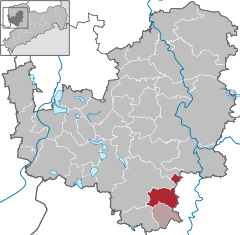Geithain
| Geithain | ||
|---|---|---|
| ||
 Geithain | ||
Location of Geithain within Leipzig district 
 | ||
| Coordinates: 51°3′N 12°41′E / 51.050°N 12.683°ECoordinates: 51°3′N 12°41′E / 51.050°N 12.683°E | ||
| Country | Germany | |
| State | Saxony | |
| District | Leipzig | |
| Municipal assoc. | Geithain | |
| Subdivisions | 6 | |
| Government | ||
| • Mayor | Heinz Herzog | |
| Area | ||
| • Total | 30.18 km2 (11.65 sq mi) | |
| Elevation | 225 m (738 ft) | |
| Population (2012-12-31)[1] | ||
| • Total | 5,580 | |
| • Density | 180/km2 (480/sq mi) | |
| Time zone | CET/CEST (UTC+1/+2) | |
| Postal codes | 04643 | |
| Dialling codes | 034341 | |
| Vehicle registration | L | |
| Website | www.geithain.de | |
Geithain is a town in the Leipzig district, in the Free State of Saxony, Germany.
Geography
Geithain is situated 30 km northwest of Chemnitz, and 40 km southeast of Leipzig. It lies in hilly country by the wooded area Wickershain and the river Eula.
History
Development of the town
The first documented mention of the town was in the year 1186 in a document, which described the donation of earnings from the Wickershainer Marion Church to the Bishop of Merseburg through the Duke Dedo von Rochlitz.
The name of the town has its origins in the Old Sorbian word "Chytan" (Chyten) and describes the place of Chyten, where "Chyt" (Chit) is a Sorbian first name.
In 1209 there was another documented mention of Geithain and the already established Nicolai Church. In this year the establishment of a hospital and a chapel (of St. James) was ordered by Konrad II of Groitzsch(1190-1210), the Margrave of Lausitz. Also, although Geithain is described as a town in this document, a charter with the first Mayor (Silvester Phil) is first evident for the year 1335. From 1346 cisterns and wooden water conduits were constructed in Geithain, which were used until 1904.
Gaithain was administered in the Middle Ages by a Vogt, who had his seat in the Freihof, first mentioned in 1349. The Geithain powder-tower, today one of the sights of the town, was part of the Freihof and was inserted with this into the town's fortifications.
In World War II the town had 219 dead. On the 13 April 1945 alone 13 people were killed in a single air raid on the town. The target of the low flying aircraft was the railway station. On the 14 April the second World War ended for Geithain with the arrival of the American troops.
References
- ↑ "Statistisches Landesamt des Freistaates Sachsen – Bevölkerung des Freistaates Sachsen jeweils am Monatsende ausgewählter Berichtsmonate nach Gemeinden". Statistisches Landesamt des Freistaates Sachsen (in German). 17 June 2013.
